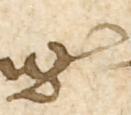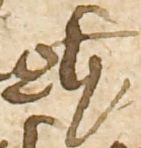|
| A |
 | Usage: called
the scribe uses a mixture of double compartment and secretary 'a's. Single 'a' as an indefinite article is usually double compartment. Many phrases begin with 'And' and the 'A' is also usually double compartment. Double compartment 'a' used frequently when it is the initial letter. |  | Usage: walles |
 | Usage: And
upper case 'A' at the beginning of a phrase. |  | Usage: And |
|
| D |
 | Usage: called
the shape and form of 'd' varies surprisingly little. 'd' is always looped. |  | Usage: And
occasionally the scribe does not close the bottom lobe of the letter. |
 | Usage: doon |  | Usage: And
a sharper point to the upper loop. |
|
| G |
 | Usage: yong
note the extended horizontal slash which appears constantly. When 'g' is used medially, the stroke joins on to the next letter. |  | Usage: rentynge
the combination 'ge' at the end of a word. The lower compartment of 'g' is triangular in appearance. |
 | Usage: wepyng
'g' with tag. |  | Usage: nough
the combination 'gh'. |
|
| H |
 | Usage: doghter
the typical formation of 'h'. The tail descends and turns counter-clockwise at the end. |  | Usage: her
the head stroke varies in angle and thickness. |
 | Usage: hise
here the head stroke is closed. | | |
|
| R |
 | Usage: thre
long 'r' used throughout in all positions. |  | Usage: mortal
'z'-shaped 'r' always used after 'o'. |
 | Usage: ȝour
'r' with hook as if for abbreviation of 'e'. |  | Usage: doghter |
|
| S |
 | Usage: his
sigma 's' is the most usual 's' in final position. |  | Usage: ladres
another version of final 's' used quite frequently, usually with down-turning tag to finish. |
 | Usage: seyth
long 's' as two separate and defined strokes. |  | Usage: Senec
upper case letter. |
|
| W |
 | Usage: wyf
a 'w' with a fairly normal shape. This letter-shape varies wildly. |  | Usage: went
the left limb of the graph extends to the left at a forty five degree angle. |
 | Usage: wepyng
the quasi 'B'-shaped element appears to be an after-thought. |  | Usage: sorwe
I'm not quite sure what is going on here! |
|
| Y |
 | Usage: hys
'y' is frequently used instead of 'i' and is always dotted. |  | Usage: day
the second stroke is occasionally angled away from the first stroke. |
 | Usage: wyf
the tail of 'y' is often long with a curl back on itself sometimes almost to the top of the descender. |  | Usage: whyth
the tail does not taper and is a fairly thick stroke. |
|
| Yogh and thorn |
 | Usage: ȝoure
yogh used initially. The tail of yogh is similar to the tail of 'y', fairly thick and descends in a more or less vertical line. |  | Usage: auȝte
Yogh used as 'gh' replacement. |
 | Usage: þe
use of thorn here as the initial letter of the definite article. Normal 'th' is also used but þ + superscript 't' is frequently used for 'that'. |  | Usage: þys |
|
| e |
 | Usage: called
'e' as used medially. |  | Usage: faste
'e' as used in final position. |
 | Usage: Melibee
double 'ee' with the two types of 'e' following on from one another. |  | Usage: leften
showing joining stroke of 'e' to 'f'. |









































